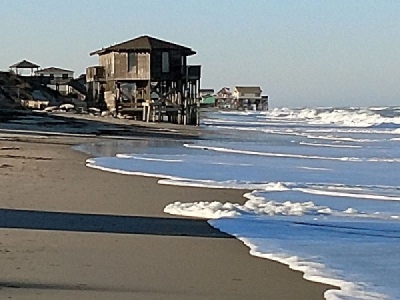
Posted on November 21, 2017
By Jeff Hampton, The Virginian-Pilot
The surf lapped at the bottom of the dune line, erasing tire tracks left only a few hours earlier on the narrow strip of sand.
Blame the shrunken strand on Hurricane Matthew, which last year consumed a third of the Nags Head beach. The most damage came at the south end of town.
“There’s one stretch up there that is pretty much impassable at high tide,” said Ryan Oliver, whose family owns the Outer Banks Fishing Pier. “We’ve lost a lot of beach.”
He said he’s looking forward to a beach nourishment project scheduled for next summer .
Nags Head plans to replenish 10 miles of its beach with 3.7 million cubic yards of sand dredged from borrow pits just offshore – if all the permits and financing come through in time. It will cost about $41 million. Vacationers could see bulldozers in front of their rental cottages through the summer.
The project has two parts.
Nags Head plans to add 2.3 million cubic yards of sand at a cost of $25.5 million. Dare County’s nourishment fund would cover up to half of that amount, said Andy Garman, Nags Head’s planning and development director.
Officials also have applied for a $16 million grant from the Federal Emergency Management Agency to replace 1.43 million cubic yards of sand lost to Matthew, he said.
FEMA funded large beach renourishment projects following Hurricane Sandy in 2012, agency spokesman David Mace said.
The total price could fall below $40 million, if the two efforts are combined into one bid, Garman said.
Engineers have divided the 10 miles into five sections of varying sizes to account for different erosion rates, among other things.
The southern end has lost the most shoreline sand since the last nourishment project in 2011, so that area will get a larger portion of fill, Garman said.
The ocean rumbles under pilings and near swimming pools in southern Nags Head, undercutting boardwalks and cutting gently sloping dunes into steep cliffs. The Olivers were forced to drive longer piles next to existing ones to shore up the rear of the pier house, he said.
The town will draw sand from the same offshore pit as the last project as well as from a new area near the north end of town. The project six years ago required 4.6 million cubic yards at a cost of $36 million.
Officials plan to get permits and financing and accept bids by April, according to a town schedule. The FEMA part has to pass through federal officials and could delay the schedule.
“Once it goes up to Washington, D.C., that’s the concern,” town engineer David Ryan told town commissioners Wednesday.
The project is under environmental review, which checks for such issues such as sea turtle nesting, Mace said. This review typically is the longest part of the acceptance process, he said.
“We’re doing everything we can at our end to get the project approved,” he said.
A long delay could force the town to do part in 2018 and part in 2019, an option that might cause problems.
Dredging sand typically costs more per cubic yard on a smaller project than on a larger one, Garman said. The contractor would have to return twice with all the equipment and the beaches would be disturbed over two seasons instead of one.
“There is a lot more efficiency by combining them,” he said.
Source: The Virginian-Pilot





